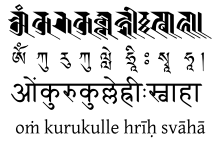Kurukullā
.jpg)
Kurukullā (Tibetan: ཀུ་རུ་ཀུ་ལླཱ་ ; also Tibetan: རིག་བྱེད་མ་, Wylie: rig byed ma "Knowledge/magic/vidyā Woman",[1] Chinese: 咕嚕咕列佛母 "Mother-Buddha Kuru[kullā]" or Chinese: 作明佛母 "Knowledge-Causing Mother-Buddha"[2]) is a female, peaceful to semi-wrathful Yidam in Tibetan Buddhism particularly associated with rites of magnetization[3] or enchantment. Her Sanskrit name is of unclear origin.[1]
Representation
Kurukullā is a goddess whose body is usually depicted in red with four arms, holding a bow and arrow made of flowers in one pair of hands and a hook and noose of flowers in the other pair. She dances in a Dakini-pose and crushes the asura Rahu (the one who devours the sun). According to Hindu astrology, Rahu is a snake with a demon head (Navagraha) who represents the ascending lunar node.
She is considered either an emanation of Amitābha, one of Tara's forms, or a transformation of Heruka.
History
Kurukullā was likely an Indian tribal deity associated with magical domination. She was assimilated into the Buddhist pantheon at least as early as the Hevajra Tantra, which contains her mantra. Her function in Tibetan Buddhism is the "red" function of subjugation. Her root tantra is the Arya-tara-kurukulle-kalpa (Practices of the Noble Tara Kurukullā).[3] It was translated by Ts'ütr'im jeya, a disciple of Atiśa.[4]
Mantra

The essential mantra of Kurukullā is Oṁ Kurukulle Hrīḥ Svāhā (Tibetan: ༀ་ཀུ་རུ་ཀུ་ལླེ་ཧྲཱིཿསྭཱ་ཧཱ ). This mantra uses the vocative form (Kurukulle) of her name.
Notes
- 1 2 Shaw, Miranda (2006). Buddhist Goddesses of India. Princeton University Press. p. 444. ISBN 0-691-12758-1.
- ↑ "Dakinis-Energie und Weisheit" (in German). Archived from the original on 2013-07-19.
- 1 2 Dharmachakra Translation Committee (2011)
- ↑ Beyer (1978), p. 302
References
- Beyer, Stephan (1978). The Cult of Tara: Magic and Ritual in Tibet. University of California Press. pp. 301–310. ISBN 0-520-03635-2.
- Dharmachakra Translation Committee (tr.) (2011). The Practice Manual of Noble Tara Kurukulle (PDF). 84000. Retrieved 2015-03-22.
- Reynolds, John Myrdhin. "Kurukulla: The Dakini of Magic and Enchantments". Vajranatha.com. Retrieved 2016-05-28.
Further reading
- Donaldson, Thomas E. (2001). Iconography of the Buddhist Sculpture of Orissa: Text. Abhinav Publications. pp. 298–301. ISBN 9788170174066.
- Shaw, Miranda (2006). "Krukulla: Red Enchantress with Flowered Bow". Buddhist Goddesses of India. Princeton University Press. pp. 432–447. ISBN 978-0691127583.
- Vessantara (2003). "Kurukulla and the Rite of Fascination". Female Deities in Buddhism: A Concise Guide. Windhorse Publications. pp. 79–81. ISBN 9781899579532.
External links
| Wikimedia Commons has media related to Kurukullā. |
- Kurukulla Main Page at HimalayanArt.com
- The Practice Manual of Noble Tara Kurukulle - translated from the Tibetan canon - at 84000.